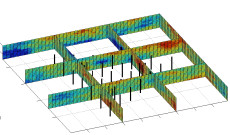New Approaches for Understanding the Hanford 300 Area
Key Challenges: Simultaneously generate an ensemble of results for tens to hundreds of thousands of subsurface flow and transport simulations to characterize uncertainty of the parameters to those simulations. Use inverse modeling to help validate a field-scale reactive transport model of subsurface uranium migration processes. One of the main challenges is integration of datasets (e.g., from field pumping or injection tests) of different types and scales.
Why it Matters: Pacific Northwest National Laboratory (PNNL) is leading an IFRC (Integrated Field Research Challenge) project at the Hanford Site in Richland, Washington to identify new approaches and strategies for resolving questions about the movement of subsurface contaminants. During the 5-year project, researchers will develop and validate a field-scale reactive transport model of the subsurface migration processes that describe uranium discharges into the Columbia River. The goal is to predict future contaminant fluxes and the efficacy of proposed remediation strategies.
Accomplishments: A new Bayesian geostatistical inversion framework, "Method of Anchored Distributions," has been developed and applied to, and validated against, Hanford 300 Area IFRC test data. The method is more rigorous than previous approaches that may have hindered adoption of inverse modeling in the past. The massively parallel, multiphase, multicomponent reactive flow and transport code "PFLOTRAN" was also used at NERSC to simulate a tracer test at the Hanford IFRC site on each of multiple randomly-generated 3-D heterogeneous hydraulic conductivity fields. Using the results of these multiple tracer test simulations, the actual tracer test conducted at the site for characterizing the heterogeneous conductivity field was inverted including uncertainty associated with data. The resultant fields will become input for simulating a uranium transport experiment planned next year.
Investigators: Yoram Rubin, UC Berkeley
More Information: See Hydrol. Earth Syst. Sci., 14, 1989–2001, 2010 and Professor Rubin's web site.








